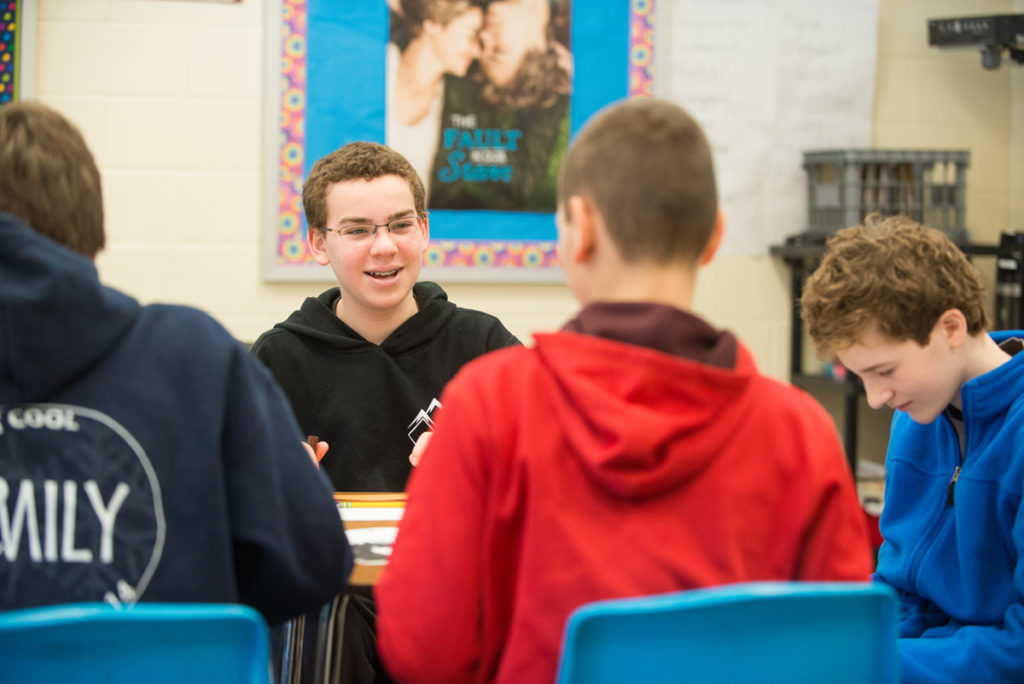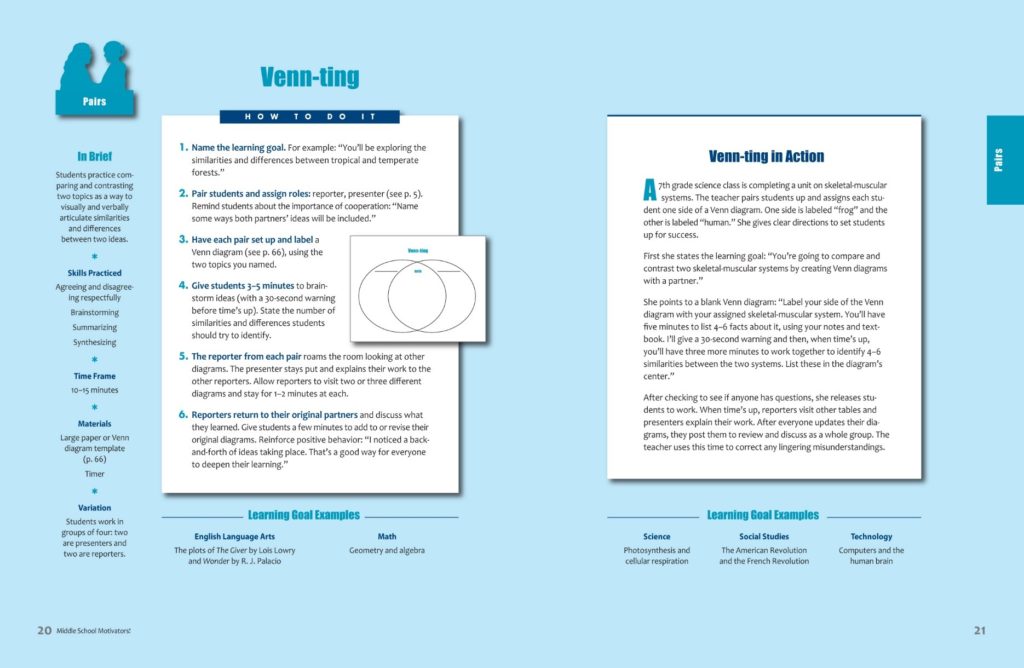
As middle schoolers begin the transition into young adulthood, they have a strong developmental need for learning that’s both active (hands-on, experiential) and interactive (social, collaborative). When we meet that need, students are more likely to behave in positive ways and engage more deeply with academics. But how can we build such dynamic learning into the short periods and packed curriculum typical in most middle schools? Motivators—interactive learning structures—are one excellent way.
Interactive learning structures motivate students by giving them the activity and interaction they crave while also building their social-emotional skills and firing up their interest in academics. For example, suppose you want students to discuss similarities and differences between two historical periods, scientists, or ways of solving a math problem. Instead of having everyone sit and talk with just one partner, you could try an interactive learning structure like Venn-ting, which combines partner discussion with moving around the room to learn from other classmates. Here’s how it’s done (click for full size):

Interactive learning structures also help maintain order and purposefulness in the classroom. Their built-in structure enables you to quickly organize students into pairs or small groups. Easy-to-follow steps then help students stay focused and guide them as they work together on a specific learning goal, assignment, or project.
These learning structures are versatile, too; you’ll find many opportunities to use them with all of your classes, no matter the content you teach, students’ grade level, or the learning goal. You can use motivators to help students:
Here are some ways you can use interactive learning structures in your classroom.
You might want to begin with structures for pairs of students. Then, as you get comfortable with structures for pairs and students learn how to meet behavioral expectations when doing them, try small-group and whole-class structures.
Don’t worry about learning all of these structures. It’s fine to stick with a handful that work well for your teaching purposes. Not only will a structure feel different to students when you use it with different content, but classes often enjoy the sense of competence and community that comes from repeating structures they know well. Add in a new one now and then to keep things fresh.
For some goals, such as learning to craft an argument, you’ll want students to begin by working in pairs so they can focus on building skills rather than sorting information from multiple classmates. To meet other goals, such as understanding multiple perspectives or reviewing content, whole-group learning structures work well because they enable students to hear lots of ideas.
Make sure you have enough room for students to do the structure safely and efficiently since some movement is often involved.
Because middle schoolers are rapidly changing cognitively, emotionally, and physically, it’s important to consider how easily they can do what a structure requires. For example, at age eleven, as concerns with forming close friendships grow, girls tend to form cliques. They may need help with being inclusive for structures that involve working with multiple classmates.
Another example: boys from eleven through thirteen tend to be physically awkward and may lack the motor control to do a lively structure in a small space without bumping into others.
Any structure should be relatively easy for all students to do so that they can concentrate on meeting learning goals, rather than learning how to do the structure. It’s important, therefore, to teach (or review) key skills needed for each structure before you do it “for real.” Besides freeing students to concentrate on learning, you’ll also help them avoid the embarrassment young adolescents often feel when making mistakes in front of peers.
The Responsive Classroom practice called Interactive Modeling is a quick, effective way to teach specific skills needed for doing a structure; see the box below for an example of how it works.
Consider the learning goal and students’ abilities and interests; then decide whether to group randomly or by similar or mixed abilities or interests. When students are ready to be respectful and inclusive, they can try choosing their own partners or groupmates.
While students are doing a structure, use reinforcing language, reminding language, and open-ended questions to help ensure their success.
Emphasize that you expect everyone to contribute because everyone’s efforts are essential to success.
To truly collaborate, students need to understand their roles and responsibilities when doing these learning structures. Some typical roles and responsibilities needed:
After students have used a learning structure, reflect on what went well and what didn’t. Then adjust as needed next time.
Easy to do, structured but fun, useful for building both academic and social-emotional skills—interactive learning structures have a lot to offer middle school teachers and students. The payoffs for the few minutes of class time needed to teach them can be substantial: more effective use of teaching time for you, deeper understanding and motivation for students, and a classroom community where everyone loves to learn.
This article is an adapted excerpt from Middle School Motivators! 22 Interactive Learning Structures. This book gives middle school teachers a simple but powerful tool they can use to enliven content and engage students in their learning, while promoting positive behavior.